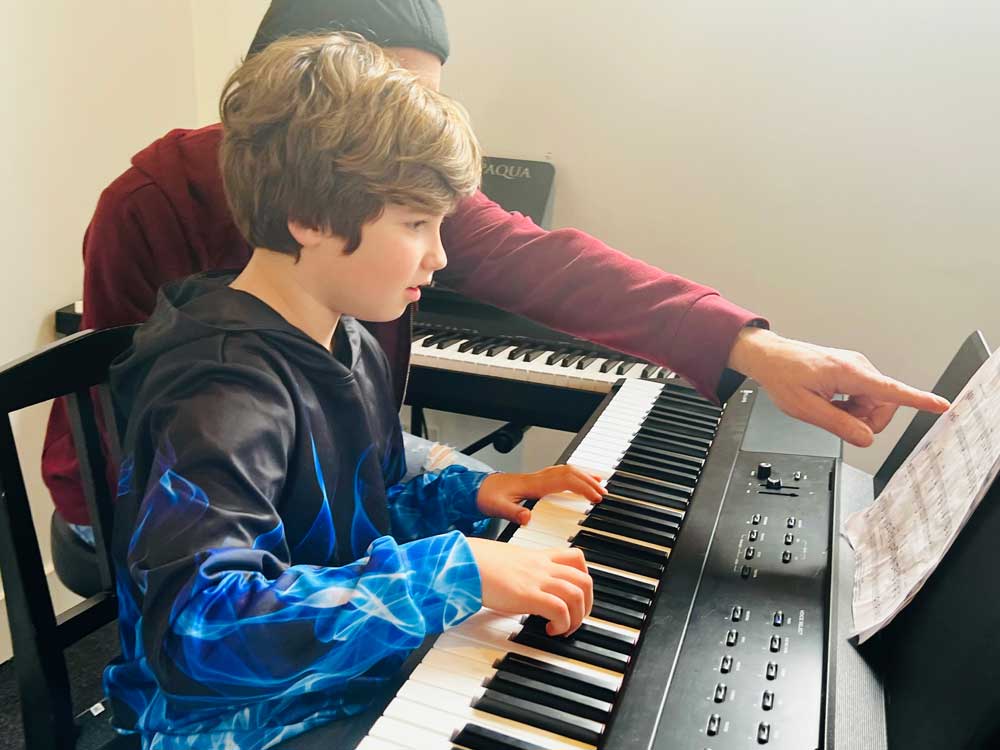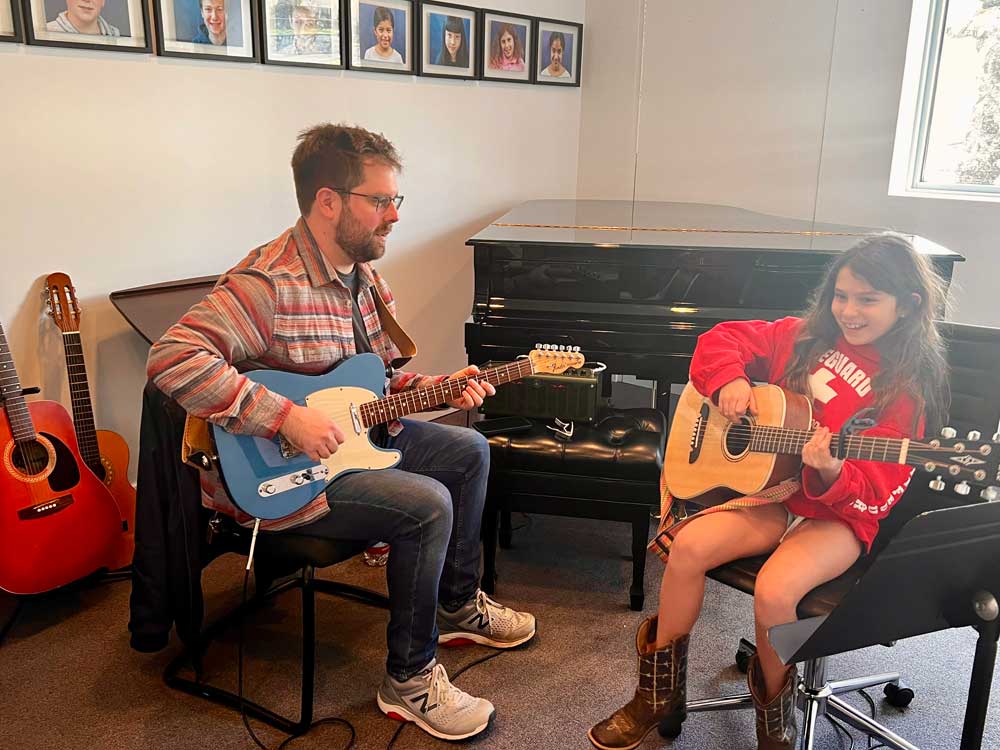Practice Tips
Encouraging children to practice a musical instrument can be a challenging task. At Music in Chappaqua, we believe that with the right approach and strategies, it is possible to make practice time both engaging and enjoyable. Here are our top suggestions we’d like to share:
- Set realistic goals: Start by setting achievable practice goals for your child. It can be as little as five minutes a day. As your child gets into the routine, increase practice time slowly with positive feedback.
- Create a practice schedule: With so many activities in children’s lives, it’s important to carve out practice time. Like learning to read requires a parent’s daily support, so too will a consistent practice routine help facilitate a life-long love of music.
- Make it fun: Find ways to make practicing enjoyable for your child. Incorporate games, challenges, or rewards to keep them motivated and engaged. Use colorful stickers, a practice chart, or a progress tracker to visually represent their achievements.
- Provide positive reinforcement: Encourage and praise your child’s efforts, even if they make mistakes. Focus on their improvements and celebrate small victories along the way.
- Be patient and supportive: Understand that learning a musical instrument takes time and effort. Avoid putting too much pressure on your child and offer support and guidance instead.
- Choose repertoire they love: Help your child communicate with their teacher about their favorite songs. This can make practicing more enjoyable and meaningful for them.
Age-Appropriate Approaches
For your 2-3 year old, practice should be play!
- Begin with no more than 2-5 minutes for music time at home every day. This can be extended as long as there’s joy in the air!
- Feel free to play with singing or drumming, marimba, xylophone, drums, or even the piano.
- Use call and response. Play a simple beat and see if your child can repeat what they hear.
For your 3-5 year old:
- Always be present while your child is practicing. Before age 5, children need lots of guidance and support. Cultivating presence while in your child’s early music practice is key.
- Dedicate a space. Set the tone by making an inspiring music corner. Set up practice materials in advance. Clear the area from distractions.
- Prioritize play. Ask your private teacher for ideas on how to turn practice moments into games that you can play during music time at home.
- Choose the right time for your child to practice and create a transition period from the last activity.
- Play! Ask your private teacher for ideas on how to turn practice moments into games to play at home.
For your 6-8 year old:
- Use measurable goals. After every lesson, make sure that you and your child both have a firm understanding of what your teacher would like for them to practice. Make that thing a “team goal” during the week, and celebrate your child as they work toward it.
- Make it personal. Add an element of reward to your child’s practice that shines on their personality and interests. For an arts and design lover, consider creating a practice chart to be filled with colorful entries. For a child who loves making people laugh, consider making part of their practice time goofy with jokes. For a child who strives to achieve, place special emphasis on celebrating accomplishments that are large and small, visible and less visible.
For your 9-11 year old:
- Keep it positive. Never before has your child needed so much positivity and encouragement! As a parent, the goal is to consistently provide positivity and support.
- Teach resilience. Tolerate feeling frustrated, and tolerate feeling confused. When you’re learning a new skill, you’re working on weaknesses and it’s normal for this process to feel frustrating and confusing. Learn to recognize these feelings when they occur in your child. Consider normalizing them by reminding your child that these feelings indicate that they are in the “stretch zone,” in a time of growth. It’s not a bad sign, it’s actually a sign to keep going.
For your 12-14 year old:
- Practice deliberately. Use concrete, measurable goals. As opposed to shallow practice, having a specific goal is a research-backed method for achieving optimal practice results.
- Be inspiring. Refer to expert players, performances, and pieces. Search for that feeling of excitement, and draw out a way for you to apply the skills that they possess now and that lie on the horizon. Show your young teen what’s possible!
- Allow them to be the expert. Let them teach you a lesson, let them show you how they’ve learned what they know now.
For your 15 year old and older teen:
- Honor independence. At this age, some students naturally take higher levels of responsibility for managing their own practice. Praise them for taking initiative, and reward them when that initiative pays off.
- Acknowledge life’s changes. When your student’s repertoire or technique gets harder than what they’ve gotten used to in their earlier teenage years, it’s easy for them to feel disinclined and want to ease up, or slow down, on practicing. Have meaningful conversations with your child that normalizes and puts these changes in perspective. Relieve them of feeling the need to make practice look or feel like it might have before. Offer ways to keep going.
- Inspiration is key. Refer to expert players, performances, and pieces. Search for that feeling of excitement, and draw out a way for them to apply the skills that they possess now and that lie on the horizon. Show your older teen what’s possible!
For All Ages
As Early As Possible…
Be immersed in music.
We believe that music is, above anything else, for the joy of creative expression. Immerse your home in music. Collect and play your favorite records on the stereo system. Dance and sing at home. Talk about these pieces, and focus on what makes you feel. Work conversations about music into everyday life. When your children express interest in what they’re hearing, you can then match them where they are by connecting them to the resources that music lessons provide.
Be present with your child.
It makes a difference when you show up and listen to your child as they practice music. When you supply a reliable air of support and positivity around their work, it affirms that it is valuable, meaningful, and noticed. This is easy to do by vocalizing your interest and committing to attend your child’s practice sessions to some extent. A good place to start is with questions like: “Did you learn anything new in your lesson yesterday?” You can also say: “I know you’ve just learned another song, I can’t wait to hear it!” You can invite your child to be the expert with questions like: “What’s that you’re doing with the bow on the string?” Most importantly, you can simply sit in the presence of your child as they play music — and begin to share regular moments of musical presence together. Active listening brings curiosity to your child’s musical journey. Presence deepens their bond with the lessons they learn.
Make practice feasible.
As your child is just starting to integrate the habit of music into their lives, it is especially important that their practice time is set up to be a consistent, natural, and reliable part of your family’s day-to-day schedule. Choose a place in your home that feels well-suited to your child’s practice. Crucially, find a time that works for you and your child to work there, each and every day. Making music practice into a daily habit should be the standard for all students in private lessons. Ultimately, it teaches your child that showing up counts for everything. Results always show that consistency is the greatest measure of student success, because practice (and music) is relational; it’s defined by the relationship between your student and their instrument. The amount of time spent practicing is flexible and should adapt to suit your family. Your teacher will work to help you find that perfect span of time!
Practice deliberately
Deliberate practice, as opposed to shallow practice, is a research-backed method for achieving optimal practice results. It’s based on four principles: work on weaknesses, use full concentration, make use of feedback, and repeat to mastery.
Remember, every child is unique, and what works for one may not work for another. Be patient, flexible, and open to experimenting with different approaches until you find what resonates best with your child. Music is a wonderful form of self-expression and creativity, and with the right encouragement, your child can develop a lifelong passion for playing a musical instrument.



